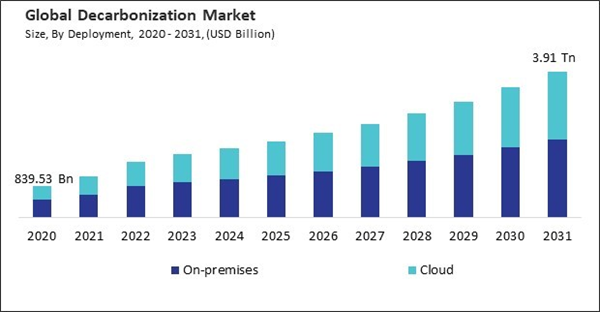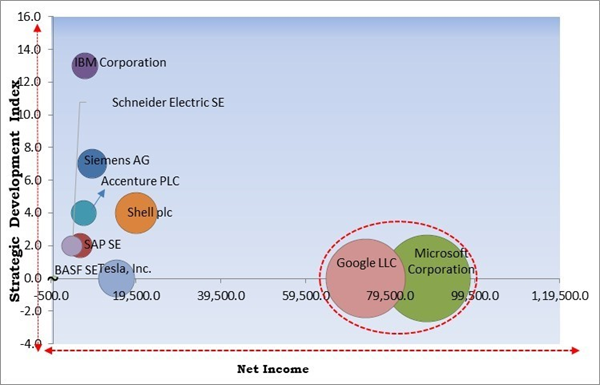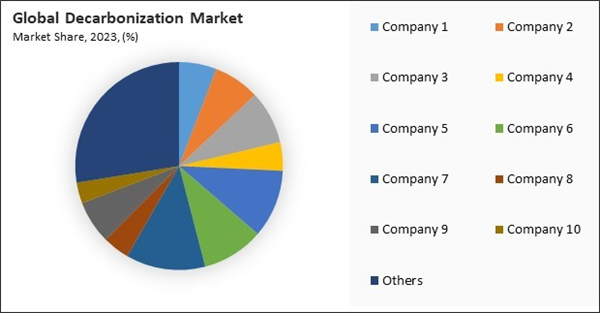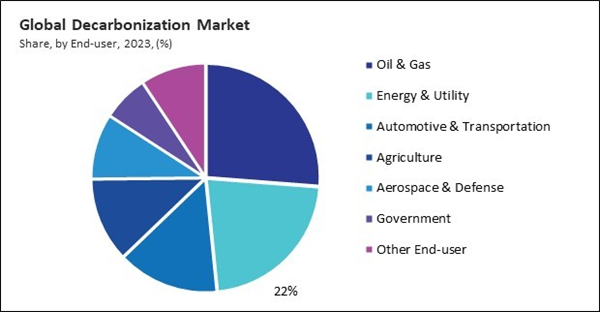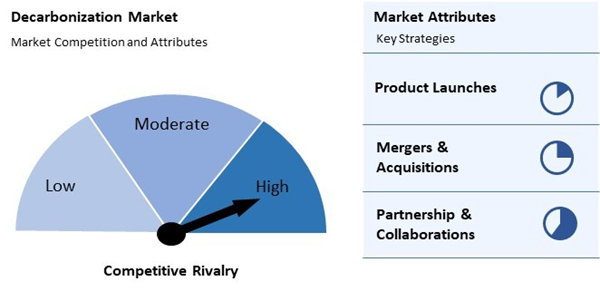The increasing global demand for sustainable and clean energy sources to reduce greenhouse gas emissions and dependence on fossil fuels drives the renewable energy technologies segment. Government incentives, such as subsidies, tax breaks, and renewable energy targets, are accelerating the adoption of solar, wind, and hydropower technologies. Thus, the renewable energy technologies segment acquired 43% revenue share in the market in 2023. Advances in technology have significantly reduced the cost of renewable energy generation and storage, making it more accessible. The rising awareness of climate change and the need for energy security have also prompted public and private sectors to invest heavily in renewable energy infrastructure.
The major strategies followed by the market participants are Partnership as the key developmental strategy to keep pace with the changing demands of end users. For instance, In September, 2024, SAP SE announced the partnership with Ambipar, a leader in environmental solutions, to launch Net Zero as a Service, aimed at assisting organizations in their journey towards carbon neutrality. This innovative service combines SAP's advanced cloud solutions with Ambipar's expertise in carbon credit generation and trading, providing customers with a comprehensive approach to managing and offsetting carbon emissions. Additionally, In June, 2024, IBM Corporation announced the partnership with JLL, a real estate company to launch a global sustainability solution. This partnership aims to enhance ESG data management and reporting for commercial real estate, enabling decarbonization strategies and improved portfolio sustainability.
Cardinal Matrix - Market Competition Analysis
Based on the Analysis presented in the Cardinal matrix; Google LLC and Microsoft Corporation are the forerunners in the Decarbonization Market. Companies such as Shell plc, Tesla, Inc., and Siemens AG are some of the key innovators in Decarbonization Market. In March, 2024, Shell plc teamed up with Bloom Energy, a Green energy company to explore decarbonization solutions using Bloom's solid oxide electrolyzer (SOEC) technology. The collaboration aims to develop large-scale hydrogen production systems, offering clean, renewable hydrogen to replace fossil fuel-based supplies.Market Growth Factors
Corporate sustainability goals are increasingly becoming a central focus for organizations worldwide. The mounting pressure to adopt environmentally responsible practices stems from heightened awareness of climate change and its impact on businesses, societies, and ecosystems. To meet the evolving expectations of stakeholders, many organizations are setting ambitious decarbonization targets. Hence, corporate sustainability goals serve as a catalyst for transformative change, fostering market growth.Additionally, technological advancements are at the forefront of the global transition toward a low-carbon economy. Developments in renewable energy technologies, such as wind, solar, and hydrogen, are revolutionizing how energy is produced and used. Solar photovoltaic (PV) systems have seen dramatic efficiency and cost reduction improvements, making them one of the most accessible renewable energy sources. Therefore, these technological advancements are not only driving decarbonization but also fostering economic growth.
Market Restraining Factors
The transition to a decarbonized economy often requires substantial financial commitments, particularly in adopting advanced technologies like carbon capture and storage (CCS), renewable energy systems, and hydrogen production facilities. While essential for reducing carbon emissions and achieving sustainability goals, these technologies involve significant upfront investments. Hence, the economic feasibility of decarbonization solutions remains a critical hurdle hampering the market's growth.The leading players in the market are competing with diverse innovative offerings to remain competitive in the market. The above illustration shows the percentage of revenue shared by some of the leading companies in the market. The leading players of the market are adopting various strategies in order to cater demand coming from the different industries. The key developmental strategies in the market are Partnerships, Collaborations & Agreements.
Driving and Restraining Factors
Drivers
- Growing Role in Corporate Sustainability Goals
- Global Urbanization and Infrastructure Development
- Technological Advancements in Decarbonization Technologies
Restraints
- Substantially High Initial Investment Costs
- Lack of Regulatory Support and Incentives
Opportunities
- Rise in Carbon Pricing Mechanisms
- Consumer Awareness and Demand for Sustainable Products
Challenges
- Lack of Adequate Infrastructure
- Resistance to Change Among End Users
Deployment Outlook
By deployment, the market is bifurcated into on-premises and cloud. The cloud segment procured 44% revenue share in the market in 2023. Cloud-based solutions support real-time data monitoring, advanced analytics, and remote accessibility, enabling organizations to optimize energy efficiency and carbon management seamlessly.End Use Outlook
Based on end-user, the market is segmented into oil & gas, energy & utility, agriculture, government, automotive & transportation, aerospace & defense, and others. The oil & gas segment acquired 26% revenue share in the market in 2023. Regulatory mandates and pricing mechanisms compel the industry to adopt carbon capture and storage (CCS) technologies, renewable energy integration, and energy-efficient processes.Services Outlook
Based on service, the market is classified into carbon accounting & reporting services, sustainable transportation services, and waste reduction & circular economy services. The carbon accounting & reporting services segment procured 25% revenue share in the market in 2023. Governments and international organizations are enforcing stricter compliance standards for reporting greenhouse gas (GHG) emissions, pushing businesses to adopt carbon accounting practices.Technology Outlook
On the basis of technology, the market is classified into renewable energy technologies, energy efficiency solutions, electric vehicles (EVs), carbon removal technologies, and carbon capture & storage (CCS). The carbon removal technologies segment witnessed 10% revenue share in the market in 2023. Growing government and corporate commitments to net-zero emissions foster investments in direct air capture (DAC), bioenergy with carbon capture and storage (BECCS), and nature-based solutions like afforestation.Market Competition and Attributes
The decarbonization market is highly competitive, driven by stringent regulations, technological advancements, and increasing sustainability commitments. Companies are investing in carbon capture, renewable energy, hydrogen solutions, and energy efficiency technologies to reduce emissions. Startups and established firms compete on innovation, scalability, and cost-effectiveness. Governments and industries are accelerating net-zero initiatives, intensifying competition. Strategic partnerships, R&D investments, and policy incentives shape the market dynamics. As carbon pricing and ESG pressures rise, firms focus on low-carbon solutions to gain a competitive edge.
Region Outlook
Region-wise, the market is analyzed across North America, Europe, Asia Pacific, and LAMEA. The Europe segment acquired 31% revenue share in the market in 2023. The region's ambitious climate goals and comprehensive regulatory frameworks, such as the European Green Deal and the Renewable Energy Directives (RED II & III), propelled the European market. These initiatives encourage the adoption of renewable energy, energy efficiency measures, and low-carbon technologies across industries. 01Recent Strategies Deployed in the Market
- Sep-2024: SAP SE announced the partnership with Ambipar, a leader in environmental solutions, to launch Net Zero as a Service, aimed at assisting organizations in their journey towards carbon neutrality. This innovative service combines SAP's advanced cloud solutions with Ambipar's expertise in carbon credit generation and trading, providing customers with a comprehensive approach to managing and offsetting carbon emissions.
- Jun-2024: IBM Corporation announced a partnership with JLL, a real estate company, to launch a global sustainability solution. This partnership aims to enhance ESG data management and reporting for commercial real estate, enabling decarbonization strategies and improved portfolio sustainability.
- Jun-2024: IBM Corporation unveiled Maximo Emissions Management, an AI-powered tool for asset-intensive industries to track and manage emissions. Integrated with IBM Envizi, the solution enables real-time monitoring, incident reporting, and emissions impact analysis, supporting sustainability and decarbonization while extending asset lifespan and improving productivity through AI-driven operational insights.
- Mar-2024: Shell plc teamed up with Bloom Energy, a green energy company to explore decarbonization solutions using Bloom's solid oxide electrolyzer (SOEC) technology. The collaboration aims to develop large-scale hydrogen production systems, offering clean, renewable hydrogen to replace fossil fuel-based supplies.
- Nov-2023: IBM Corporation teamed up with Deloitte, a business consulting and services company to streamline ESG data management, gain actionable insights, and enhance sustainability strategies. This collaboration helps clients accelerate decarbonization efforts, optimize operations, and meet sustainability goals through data-driven insights and strategic transformation.
- Mar-2023: IBM Corporation teamed up with EY, a accounting company to enhance sustainability offerings, focusing on strategy, data management, and linking sustainability with financial performance. This collaboration integrates IBM’s carbon management software with EY’s advisory services to address Scope 3 emissions, financed emissions, and ESG Managed Services, advancing decarbonization for asset-heavy industries.
- Jan-2023: Schneider Electric SE teamed up with Bain & Company to support corporate decarbonization efforts. The collaboration combines Bain’s advisory expertise with Schneider Electric’s digital decarbonization solutions to help businesses meet climate goals.
- Sep-2022: Accenture PLC acquired Carbon Intelligence, a climate data and analtics company to enhance its sustainability services. This acquisition strengthens Accenture’s capabilities in carbon measurement, strategy, and decarbonization using Science Based Targets, enabling clients to achieve low-carbon goals.
- Jun-2021: Shell plc teamed up with Rolls-Royce, a Aerospace company to accelerate the aviation industry's decarbonization efforts. The collaboration will focus on advancing sustainable aviation fuel (SAF) usage, exploring SAF solutions, and working on policies to achieve net zero emissions, while reducing operational emissions and supporting broader mobility sectors.
List of Key Companies Profiled
- IBM Corporation
- Accenture PLC
- Siemens AG
- SAP SE
- Tesla, Inc.
- Shell plc
- Schneider Electric SE
- Google LLC (Alphabet Inc.)
- Microsoft Corporation
- BASF SE
Market Report Segmentation
By Deployment
- On-premises
- Cloud
By Technology
- Renewable Energy Technologies
- Energy Efficiency Solutions
- Electric Vehicles (EVs)
- Carbon Removal Technologies
- Carbon Capture and Storage (CCS)
By Service
- Sustainable Transportation Services
- Carbon Accounting and Reporting Services
- Waste Reduction and Circular Economy Services
By End-user
- Oil & Gas
- Energy & Utility
- Automotive & Transportation
- Agriculture
- Aerospace & Defense
- Government
- Other End-user
By Geography
- North America
- US
- Canada
- Mexico
- Rest of North America
- Europe
- Germany
- UK
- France
- Russia
- Spain
- Italy
- Rest of Europe
- Asia Pacific
- China
- Japan
- India
- South Korea
- Singapore
- Malaysia
- Rest of Asia Pacific
- LAMEA
- Brazil
- Argentina
- UAE
- Saudi Arabia
- South Africa
- Nigeria
- Rest of LAMEA
Table of Contents
Companies Mentioned
- IBM Corporation
- Accenture PLC
- Siemens AG
- SAP SE
- Tesla, Inc.
- Shell plc
- Schneider Electric SE
- Google LLC (Alphabet Inc.)
- Microsoft Corporation
- BASF SE
Methodology

LOADING...



